UB School of Economics research shows that high trade costs have historically hindered inter-regional trade in South America
 UB School of Economics researchers Marc Badia-Miró and Anna Carreras-Marín and University of California, Davis researcher Christopher M. Meissner have found that high trade costs have historically hindered regional trade in South America and favoured exchanges with more distant partners, such as the US, the UK, France and Germany. The authors of the study estimate that Argentina, Bolivia, Brazil, Chile and Peru might have been able to double exports to each regional partners under a free trade scenario comparable to the decline in trade costs from the First and Second World Wars. The study also finds that other policies to improve transport and communication links could have had similar effects.
UB School of Economics researchers Marc Badia-Miró and Anna Carreras-Marín and University of California, Davis researcher Christopher M. Meissner have found that high trade costs have historically hindered regional trade in South America and favoured exchanges with more distant partners, such as the US, the UK, France and Germany. The authors of the study estimate that Argentina, Bolivia, Brazil, Chile and Peru might have been able to double exports to each regional partners under a free trade scenario comparable to the decline in trade costs from the First and Second World Wars. The study also finds that other policies to improve transport and communication links could have had similar effects.
The two world wars made it relatively more costly to trade with those nations directly involved in the war and relatively less costly to trade within the region. The First World War brought an increase from around 5% to a maximum of almost 8% in 1918. Then, the global crisis of the 1930s produced a drop to 4.6% in 1931. However, inter-regional trade during the Second World expanded significantly, to 13.5% by 1945. These results were published in the journal The Economic History Review under the title “Geography, policy, or productivity? Regional trade in five South American countries, 1910-50”.
Marc Badia-Miró, co-author of this study, commented that “the latest commodity price boom pushed Latin American economic expansion but it also weakened inter-regional integration. Knowing the weaknesses of inter-regional trade in the past can offer new economic policy tools to overcome changes in the global economy. In that sense, the reduction of tariffs, economic cooperation and the strengthening of trade agreements in the region can boost economic integration and, in the long run, the economic growth”.
The authors explain that regional trade in South America since independence has been low, especially when compared to regional trade in Europe, North America and even Asia. It has even been much smaller than it would be expected if geography were the only constraint on trade. Potential explanations include low technological and demand complementarities, low productivity and high natural and policy barriers to trade. Our researchers have proven that reductions in trade costs would have been sufficient to raise trade significantly.
Badia-Miró, Carreras-Marín and Meissner consider the war periods as natural experiments that provide clues as to whether trade costs were an important driver of regional integration. These shocks have proven that intra-regional trade could have been boosted by reductions in trade costs. Nevertheless, the gains in market share were surrendered because South American nations failed to commit to permanently low trade barriers by signing a definitive regional trade agreement or a customs union. Without these incentives, the necessary investments required to establish export links to these markets were not made.
A sustained increase of inter-regional trade in South America would have significant benefits for the region. According to Marc Badia-Miró, “the reduction of inter-regional trade barriers, jointly with economic cooperation, could increase the dimension of the market potential of South America and favour economic diversification, specifically, industrial diversification, and could push economic growth in the long run”. He also explains the novelty of their study: “We go deeper into the analysis of inter-regional trade barriers in a period of huge external shocks, at the beginning of the industrialisation in the Southern Cone. We also provide a new dataset of inter-regional trade for the interwar period”.
Recent news
- Four Researchers from the UB School of Economics awarded by the State Research Agency
- 24 Researchers join the UB School of Economics in 2023 and early 2024
- The 5centims.cat blog presents its article 250 at the faculty of Economics and Business
- "A Multidisciplinary Approach Is Essential for Understanding Poverty Dynamics and Economic Policies"
- Two UB School of Economics PhD Students awarded with SEBAP Mobility Grants
- Apply for the PhD in Economics with entry funding opportunities for 2024-2025 academic year
- AGAUR Awards Grant to UB School of Economics for Climate Change Research
- The UB improves positions and is listed among the top 100 universities worldwide in the Webometrics ranking
- Citizens would only give up free elections in exchange for a threefold increase in income, according to research by the UB

Sorry, the comment form is closed at this time.